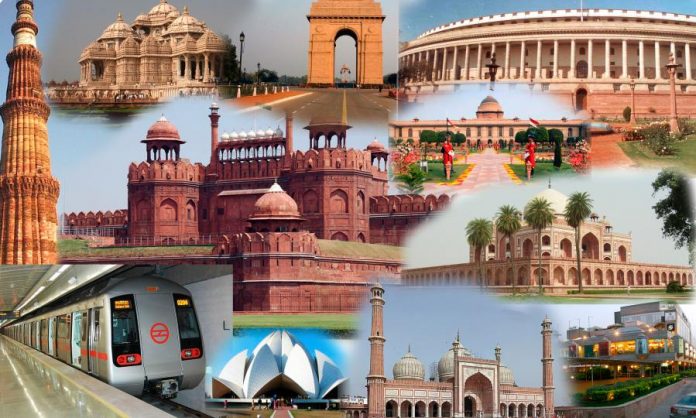Hello everyone! Hope you all are doing well. Today, we are here with a blog on India’s Capital Territory: DELHI. Delhi officially known as the National Capital Territory of Delhi (NCT), is a massive metropolitan city in the country’s north. In this blog, we will be going through some major aspects of Delhi i.e. culture, geography and political aspects.
Which city of India is the second most populated city in the world after Tokyo? Where is Asia’s largest wholesale spice market in India?
Let’s start exploring this amazing union territory of India.
Delhi is often said to be “Dil waalon ki Dilli”, which signifies a place wherein people have contented hearts and lively nature. Delhi is considered as the stem of India from its high number of ancient, historical pasts and also home to all the three branches of Government of India.
Let’s take a glance over the culture of this union territory.
Table of Contents
CULTURE Delhi GK Notes 2021:
Delhi is the present-day capital as well as union territory of India. It is a cosmopolitan city where people are open to embracing new ideas and lifestyles. Delhi has a chaotic asymmetric beauty.
Language and Culture
- Hindi is the official language of Delhi. More than 80% of the Delhi population speaks Hindi. English is the most common foreign language preferred.
- No matter how many religious communities are present in Delhi, there is harmony among this diversity. Temples, mosques, churches, and Gurudwaras stand side by side and stay as one single community called as Delhiites.
- The traditional dress of the Delhi population has a connection with Turko-Persian culture and Turko-Mongol culture.
- The women population wears salwar kameez or saree while the male population wears sherwani or kurta.
Food
- Traditionally, a mixture of ancient Indian and Mughal styled cuisine is considered as authentic Delhi cuisine.
- Street foods occupy a major part of the cuisine of Delhi. For example, lassi, kebab, chole bhature, jalebis, falooda, samosa, butter chicken, Nihari, kulfi, are the top street foods.
Arts and Festivals
- Major traditional dance forms enjoyed in Delhi are Kathak, folk dance, Bhangra, and Bharatanatyam.
- Main traditional music forms of Delhi are Carnatic, Hindustani and Ghazal.
- Major Festivals celebrated in Delhi are Independence Day, Republic Day, Phoolk walon ki Sair (festival of flowers), Qutub Festival, International Mango festival, Diwali, Holi, Navaratri, Dusshera etc.
- There are other festivals and fairs also that are celebrated in Delhi.
- Art and paintings are a major part of the tradition of Delhi. Art and paintings got immense importance in Delhi since the Mughal period.
- Delhi embroidery is famous all over the world. The cloths having different types of embroideries are used for making salwar kurtas, sarees, and bedsheets etc.
Monuments
- The Archaeological Survey of India recognises 1,200 heritage buildings and 175 monuments as national heritage sites.
- Three World Heritage Sites namely Red Fort, Qutub Minar and Humayun’s Tomb are situated in Delhi.
- The Mughals and the Turkic rulers constructed several architecturally significant buildings in the city, such as the Jama Masjid (India’s largest mosque) and the Red Fort etc.
- The Laxminarayan Temple, Akshardham temple, Gurudwara Bangla Sahib, Lotus Temple and the ISKCON temple are examples of modern architecture.
- Chandni Chowk is a market since 17th century which is one of the most popular shopping areas in Delhi for jewellery and Zari saris.
Let’s talk about the geographical aspects of Delhi.
GEOGRAPHY Delhi GK Notes 2021:
Delhi is a city and national capital territory located in north-central India. The city, Delhi literally consists of two components: Old Delhi and New Delhi in the south.
Total area: 1,484 km²
Total population: 1.9 crores
Latitude extension: 28.7041° N
Longitude extension: 77.1025° E
- The territory is bounded by Uttar Pradesh to the east, and to the north, west, and south it is bounded by Haryana.
- The total forest cover of Delhi is 195.44 sq. km, which is 13.18% of the NCT’s (National Capital Territory) area.
- Yamuna flows through Delhi. It passes by Delhi and then into Agra, and it finally ends into the Ganges.
- There is only one Wildlife Sanctuary in Delhi namely Asola Bhati (Indira Priyadarshini) Wildlife Sanctuary.
Climate:
The climate of Delhi is an overlap between monsoon-influenced humid subtropical and semi-arid with high variation between summer and winter temperatures and precipitation. Overall rainfall in Delhi amounts to about 800 mm per year.
Soil type:
The soils of the Delhi area are mostly light with a subordinate amount of medium texture soils. The light texture soils are represented by sandy, loamy, sand and sandy loam; whereas medium texture soils are represented by loam, silty loam.
Let’s study about political aspects of Delhi.
GOVERNMENT AND POLITICS Delhi GK Notes 2021:
The city government is headed by the Mayor. The Municipal Corporation of Delhi (MSD) was branched into three bodies, the North Delhi Municipal Corporation (NDMC), the South Delhi Municipal Corporation (SDMC) and the East Delhi Municipal Corporation (EDMC). Thus Delhi has three mayors. The Chief Minister and Governor are the heads of the State Government. Arvind Kejriwal is the current and 7th Chief Minister of Delhi since February 2015. The present Legislative Assembly of Delhi is unicameral that consists of 70 members of the legislative assembly (MLA). A lieutenant governor, who is appointed by the president of India, is the chief administrator of the national capital territory that is assisted by a chief minister.
Representation of Delhi in Parliament:
- Lok sabha: 7
- Rajya sabha: 3
- First lieutenant Governor of Delhi: Aditya Nath Jha
- First Chief Minister of Delhi: Ch. Braham Prakash
SOME INTERESTING FACTS ABOUT DELHI:
- Khari Baori market, Delhi is the home to the largest market of spices in Asia.
- Delhi has the 13th largest metro rail network in the world.
- Delhi is the second most populated city in the world after Tokyo.
- After Nairobi, Kenya, Delhi stands the second most bird-rich capital in the world. The Delhi ridge inhabits a large number of bird species.
- Entire public transport system in Delhi runs on CNG (Compressed Natural gas).
Hope this disquisition made most of your facts clear about Delhi. In our upcoming write-up, we will be discussing about other important aspects of Delhi.
How Delhi is historically important in India’s independence? Why Delhi is called ‘Lutyens Delhi’? How much Delhi contributes to the Indian economy?
In our subsequent blog, the factors corresponding to these questions will be answered surely. If you don’t want to miss it, click here – Know your State ‘Delhi’ – Part 2. We hope it will help you in the preparation of your competitive exams such SSC 10+2, SSC CGL, CDS, NDA, etc.
Thank You




